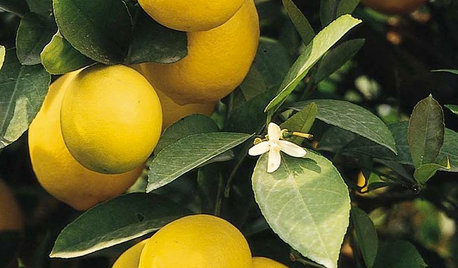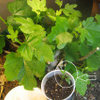Meyer lemon
laura441
9 years ago
Related Stories

COLORFUL HOMESThe Best of My Houzz: 10 Living Rooms With Wall Colors to Love
Jet black, Meyer lemon yellow, mossy green — these spaces make a statement with bold color
Full Story
GARDENING GUIDESHow to Keep Your Citrus Trees Well Fed and Healthy
Ripe for some citrus fertilizer know-how? This mini guide will help your lemon, orange and grapefruit trees flourish
Full Story
GARDENING AND LANDSCAPINGCitrus 101: Start Your Own Backyard Orchard
This Earth Day Weekend, Add Some Green, Style and Deliciousness to Your Landscape
Full Story
GARDENING GUIDESSpring Citrus Care Reaps Months of Sweet Rewards
Learn how to tend citrus trees in spring and ways to preserve their delicious fruit
Full Story
FARM YOUR YARDHow to Grow Vegetables in Containers
Get glorious vegetables and fruits on your patio with a pro’s guidance — including his personal recipe for potting mix
Full Story
HOUSEPLANTSIndoor Winter Gardens for Cheerier Days
Bring plants inside for drab-days mood boosting — not to mention cleaner indoor air and protection for your greenery
Full Story
EDIBLE GARDENSHow to Grow 10 Favorite Fruit Trees at Home
Plant a mini orchard in fall, winter or early spring to enjoy fresh-off-the-tree fruit the following year
Full Story
CALIFORNIA GARDENINGCalifornia Gardener's February Checklist
Celebrate 5 California classics: plants that defy winter with bright flowers, luscious fragrance and, for some, delicious taste
Full Story
FARM YOUR YARDIf You Have Room for Only One Fruit Tree ...
Juice up a small garden with one of these easier-care or worth-the-effort fruit trees for a mild climate
Full Story
FEEL-GOOD HOME9 Ways to Boost Your Home’s Appeal for Less Than $75
Whether you’re selling your home or just looking to freshen it up, check out these inexpensive ways to transform it
Full StoryMore Discussions







hoosierquilt USDA 10A Sunset 23 Vista CA
laura441Original Author
Related Professionals
New Bedford Landscape Architects & Landscape Designers · Saint Charles Landscape Architects & Landscape Designers · Taylorsville Landscape Architects & Landscape Designers · Wakefield Landscape Contractors · Allentown Landscape Contractors · Bainbridge Island Landscape Contractors · Battle Ground Landscape Contractors · Broadlands Landscape Contractors · Commack Landscape Contractors · Dallas Landscape Contractors · Desert Hot Springs Landscape Contractors · Lees Summit Landscape Contractors · Seymour Landscape Contractors · Smyrna Landscape Contractors · South Hackensack Landscape Contractorslaura441Original Author
laura441Original Author
laura441Original Author
kathyannd
hoosierquilt USDA 10A Sunset 23 Vista CA
laura441Original Author
johnmerr
laura441Original Author
hoosierquilt USDA 10A Sunset 23 Vista CA
laura441Original Author
meyermike_1micha
meyermike_1micha